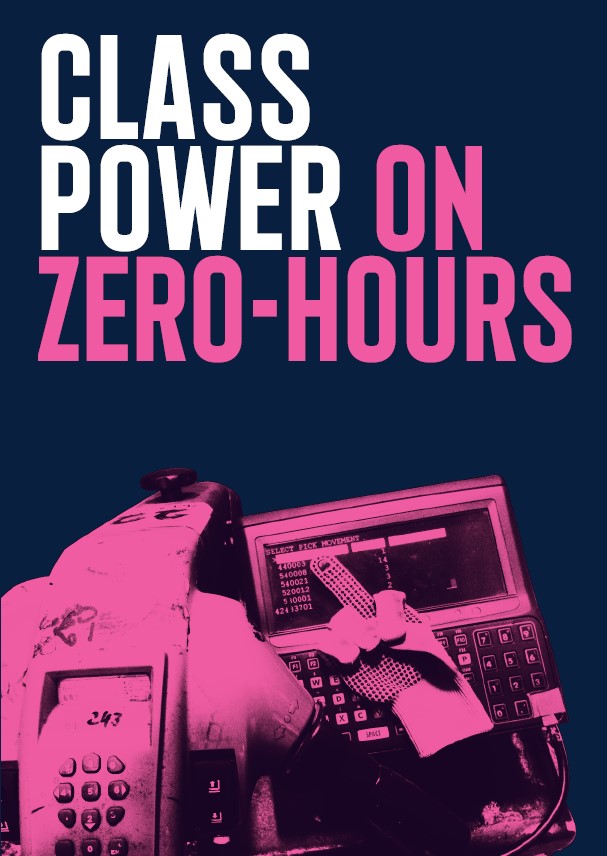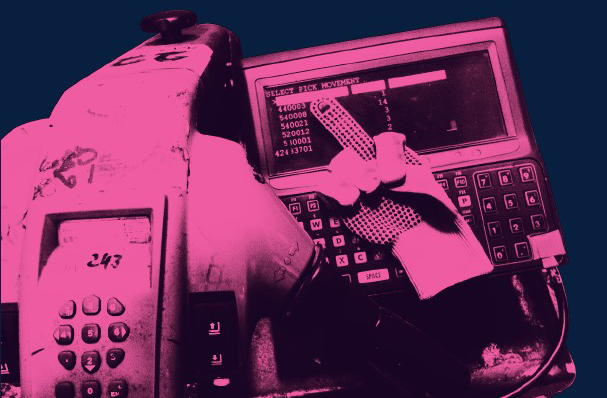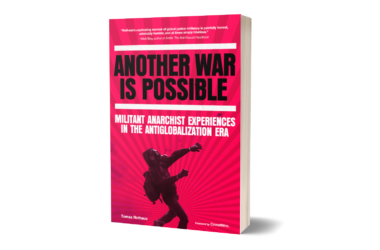By Daniel Rashid
Red & Black
November 21st, 2021
Angry Workers of the World (AWW) are a small communist collective based in London, influenced by Italian workerism and a wider array of socialist groups, like the original Solidarity (not to be confused with the Trotskyist Australian Solidarity), the women’s group Feminist Fightback and the German group Wildcat. For the past decade or so, AWW’s primary activity has been in workers’ inquiries and interventions into class struggle through a conscious strategy of “rooting” themselves in a local area, getting jobs in particular industries. Their recent book Class Power on Zero Hours is the final product of a long-term effort in West London’s logistics and food processing industries.
To get the platitudes out of the way: the book is great! One of the best socialist books released in the past decade or so. It’s well written – no bullshit, straight to the point with a good sense of humour. There’s a lot of fat to chew on even if you have disagreements with AWW’s political beliefs or strategies. The book will make you wonder why, out of all the myriad leftist groups out there, essentially none of them are currently pursuing such strategies. I mean, can’t be worse than the usual student activism, cyclical protest rallies and union staffer jobs.
The Troskyist groups that dominate the Australian far left tend to see such a workerist approach as romantic folly that was best left in the 80s, when these groups largely abandoned their “industrial concentration” strategies in favour of greener pastures for recruiting on university campuses and in activist networks. Some groups do encourage people to get jobs in specific industries and workplaces, but it’s largely with the goal of building muscle within the unions and either securing or shoring up their party’s positions in the union bureaucracy.
Workers’ inquiry
AWW’s practice is largely guided by the “workers’ inquiry” approach, inherited from the Italian workerists, that involves militants doing practical research on particular workforces. They seek to understand and describe the way people work as individuals and as a collective, how they’re moulded by capital, how capital disciplines them, how they’re exploited both at work and at home, and how they resist – even in small ways. The “inquirers” make no pretension to be neutral and are participants in the class struggle like everybody else; they act as much as they observe.
The research is not completed for academic reasons – as “learning for the sake of learning” or as something that can be submitted to an academic journal and put on a CV – but is completed as an aid for the development of the working-class against the bourgeoisie and the ultimate goal of emancipation.
Revolutionary consciousness is as much a question of knowledge as it is anything else. Workers already have the knowledge we need to do away with the ruling class, it’s just totally fragmented, due to the consciously fragmented structures of capitalist production. Put it this way: we have all the puzzle pieces, they’re just jumbled-up and out of order. In the process of associating with each other to fight the class war, we begin to put the pieces together in the right order.
The process of workers’ inquiry is one conducted through the AWW website, a local publication (WorkersWildWest) and some workplace-specific bulletins. By distributing their material at factory gates, on buses, in break rooms, etc they meet new people and begin to build connections among workers in the area at different places. So and so who stopped to pick up the paper and have a chat knows another bloke who works in a different workplace where guys are trying to kick shit off against the boss, which AWW’s solidarity network can help with. Another person in a workplace talks about a dodgy manager who is harassing people: the workplace bulletin can name and shame them. Publications become a key part of militant activity.
Whilst the workers’ inquiry approach was pioneered by the Italian workerist Marxists (those interested in learning more should read Steve Wright’s excellent book Storming Heaven) who themselves were somewhat inspired by Marx’s own worker questionnaire, it’s not so alien to anarchism and syndicalism: Proudhon and Bakunin both emphasised the necessity of the proletariat coming to a collective understanding of itself, and the French syndicalist Pierre Monatte once remarked that revolutionary unionists would achieve “un vigoureux élan” if every comrade wrote a monograph about their workplace and industry.
Trends of composition, new and old
AWW made the decision to focus on logistics and food production because it is an altogether dynamic sector, one that brings together thousands of workers in large worksites, where they are responsible for the production, processing and delivery of a large percentage of England’s food. Even before the Corona-crisis brought into view how reliant societies are on “essential jobs”, it was clear how much latent power workers held in this position securing the food supply.
In some sense, the rise of logistics and food production was a return by capital to “old” methods of organising work. Like most socialists influenced by the Italian workerists, they emphasise the way that the working-class is brought together (or brought apart) for the process of work shapes not only their exploitation, but their resistance. For instance, the Italian hot period of the 60s to early 70s was driven by the migration of substantial numbers of young workers from the south to the industrial north, where they were employed in mass industry. Having no trade or extensive technical education, they were set apart from the skilled working-class, who were ensconced in the collaborationist trade unions.
Capital “counter-attacked” the rise in wildcat strikes and insurrectionary class organisation with new developments in industrial technology and managerial techniques, that “decomposed” the new proletariat: they shifted production away from mass factories, atomised workers in the work-process, etc. Now, the demands of capital have resulted in the recomposition of a kind of mass-worker, just that instead of bolting mufflers onto Fiat 500s they’re picking ready-meal moussakas, mayonnaise and personal lubricants onto Tesco delivery trays.
Looking forward, practical experience in the industry would potentially give ideas as to how workers could manage the supply of food themselves, in a revolutionary situation. In addition, the workers in these areas are badly paid and usually of a migrant background. A large percentage of them are women, which raises the importance of looking at social reproduction outside the factory gates from a revolutionary perspective. The work-process centred on West London involves collaborating with proletarians from across the world: vegetable growers and pickers in Egypt, seafood processors in China, food production workers in Poland, and so on.
In other words: these industries represent a cross-section of everything communists are interested in. So why aren’t we getting involved with them more? The most we tend to do is engage with unions as an intermediary that we know is substandard. On unions generally, AWW hold to the fairly standard view inherited from council communists and the like, that the function of trade unions is to constrain class struggle rather than advance it.
They do, however, want to go beyond just stating this as dogma. One of the main chapters of the book details one Angry Workers’ experience getting a position as a USDAW rep in a Tesco, and another deals concretely with the new waves of syndicalism emerging in the 21st century, from the revived IWW to newer unions like SI Cobas in Italy. Some of their actions seem to be pushing their own beliefs to the max: at one point they describe their decision to become a USDAW rep as being “perhaps rather opportunistic”. Describing something like this as opportunistic is a bit odd, but is at least an acknowledgement that there’s no such thing as a closed or fixed strategic question.
Weaker points
A full commentary on the class composition/workerist perspective is out of the scope of this review, but there are certainly criticisms to be made: their emphasis on composition as the primary site of antagonism between worker and capitalist leads to a sort of determinism, minimising other factors in society – such as the way government develops in terms of parliaments and dictatorships and changes in the law; the role (or non-role) of religion; the way workers’ organisations develop and transform society with their own influence; etc.
When AWW assess revolutionary history, they have a tendency (which they half-acknowledge) to resort to easy schemas – in one text outside the book, the growth of communist parties is explained by the proletarianisation/urbanisation of the agricultural working-class and small peasantry, “councilism and revolutionary syndicalism” is explained by the development of a skilled industrial workforce, the modes of resistance in the 60s/70s are explained by the Fordist large-scale “deskilled” industries, and so on.
In Class Power itself, they say that:
“One of the earliest criticisms of capitalism and its blatant contradictions was raised from an artisan point of view, reclaiming the original promises of “bourgeois freedom”: instead of big industry we should have a network of small artisan producers and instead of big finance we should establish new forms of money for direct exchange (Proudhon etc.)”
Poor Proudhon! Made to sound like Benjamin Tucker or Kevin Carson or some kind of Bitcoin idiot. Regardless – though I naturally think things are more complex than the standard “class composition” theories suggest, AWW are certainly onto something when they point out that “the internal antagonism to mass production has not been overcome, namely that if you bring workers together in bigger numbers, there’ll be trouble” – the book itself provides some hopeful evidence that that is still the case.
Reflective writing
One of the book’s greatest strengths is its reflective quality: it’s completely devoid of the sloganeering and chest-thumping you get from a lot of other leftist texts. In the same way, they avoid the projected victimhood mentalities you see elsewhere, where the working-class is condemned to suffer in perpetuity. The working-class can fight back: it already is. They get the balance right between being honest about weaknesses whilst still never giving up on figuring out a way forward.
Still, some parts don’t feel as fleshed out as they could be. AWW is a collective and the text is written as such. Who wrote what is not identified, as is tradition among parts of the far-left, but it is also written from a consistent first-person perspective. Though the intended purpose is to de-emphasise a potentially negative individualism in favour of collective development as a whole, it does get slightly confusing when trying to figure out who is saying what. Though the formal answer is that it’s all the collective work of AWW, some chapters are written from the perspective of a woman, another is written from the perspective of a man; while one AWW member is agitating at a Bakkavor factory, the others are unmentioned and presumably doing something else; etc. There are Angry Workers doing a variety of things, but how is AWW as a collective joining them all together?
Trying to make a group something more than a simple collection of isolated individuals is obviously important, but I don’t think we can do it by simply writing as if the group is one enormous shape-shifting individual. This risks papering over some of the dynamics that have to be considered: e.g., someone who is in their 40s and has to take care of a kid might approach group engagement in a different way to a recent graduate in their 20s with few responsibilities to anyone.
AWW’s total anonymity is a bit of a problem when it comes to trying to figure out how to use AWW’s work in our own context. You’re left with an unclear sense of how AWW itself works as a collective. In one sense, writing about this would likely bring in personal factors that you don’t want to write about in a book that you hope to sell thousands of copies of. It can also be tedious. On the other, some things that go unmentioned seem rather important – how are decisions made in AWW? Are there formal roles? Does one comrade do the research, another the writing, etc? How is the printing of the newspaper funded? How is childcare managed during meetings and actions? And so on. The cornerstone of AWW’s strategy is AWW itself, but the book never really talks about it in this sense, leaving it all somewhat opaque.
What anarchists can learn from Class Power
AWW are not anarchists, but libertarian Marxists/left communists that are fairly-open minded. Overall, they’re ploughing the same ground as us, and share the same commitment to free communism over authoritarian social-democracy and Leninism. In particular, some of their reflections on the divide between “political” and “economic” tasks and organisations are relevant to anarchists, for whom this is a central – albeit usually unstated – preoccupation. Recently, they concluded a reading group on Chomsky’s Notes on Anarchism, which is altogether not the best anarchist text to engage with, but is nonetheless a positive sign that anarchists should reciprocate. It would be great to see them continue to engage with anarchism, and for anarchists to engage with them in return; the end result can only be productive.
For an anarchist like myself, the book speaks to the limitations of existing strategies for change in our milieu. The anarchist movement, whether individualist or self-consciously communist, suffers from a disordered relationship between anarchism as a theory, and anarchism as a working-class strategy. The explicit framework of the especifists is shared implicitly by most other anarchists: there is the working-class on the one hand with all its revolutionary potential, and there are anarchists on the other, who possess all the right ideas and methods. Revolutionary activity simply becomes a matter of injecting the latter into the former.
This is a viewpoint that bears more resemblance to social-democracy and Leninism than people would like to admit, postulating a hard divide between “economics” and “politics”, privileging the latter and seeing the former as inherently limited. By moving the question back to the work process, AWW allows us to reconsider the relationship between our doctrine and the class struggle. Anarchism isn’t something that’s particularly on their mind, but they inadvertently demonstrate some potential ways of getting round our current impassé.
Anarchism itself largely emerged out of class struggle, with engagement from “outsiders” like Bakunin: Proudhon’s mutualism, for instance, would have meant little without his own experiences as a proletarian and his engagement with the original Lyons mutualists. Similarly, Bakunin’s Alliance drew largely from the struggles of workers in France, Switzerland, Spain, and elsewhere; prior to his engagement with the International, Bakunin was something of an idiosyncratic revolutionary democrat.[1]
The task of militants is not to try and get workers to fit into some kind of anarchist mould, but to engage with working-class activity as it is now, to encourage it forward on its own terms. This does not mean sitting back and hoping it’ll all work out, but through thinking about what the content of anarchism is – like, say, the overcoming of politics – how this is manifested in the practical struggles of the working-class, and how we can contribute to the process. The approach of “rooting” yourself[2] with some comrades in a particular facet of working-class life and engaging in the kinds of reflective inquiries that AWW does could be one way of doing that.
Read this book!
____
[1] In an article on Bakunin’s organisational theories, René Berthier outlines how Proudhon and Bakunin conceived of the working-class’ movement towards socialism. For Proudhon, emancipation would occur when:
“1. The working class has arrived at a consciousness of itself “from the point of view of its relations with society and with the state”, he says; “as a collective, moral and free being, it distinguishes itself from the bourgeois class”.
2. It possesses an “idea”, a notion “of its own constitution”, it knows “the laws, conditions and formulae of its existence”.
3. But, Proudhon asks whether “the working class is able to deduce, for the organisation of society, practical conclusions which are its own”. He answers in the negative: the working class is not yet in a position to create the organisation which will allow its emancipation.”
Following on, late-period Bakunin’s schema is that:
“1. The proletariat accedes to class consciousness with “the real and living understand of its real evils” (Protest of the Alliance);
2. It educates itself through organised action against capital, “which convinces all the workers, in the most striking and direct way, of the necessity of a rigorous organisation in order to achieve victory”;
3. Through the freedom of political debate in the organisation and through the experience of struggles, the proletariat will then build “its real unity, first economic, then necessarily political” (Writings Against Marx).”
[2] AWW have since changed the name of their “Let’s Get Rooted” project. This is helpful to Australians, who otherwise might perceive it as being some kind of lefty swingers’ club.







